Diseases of cabbage
Content:
In this material, it will be possible to familiarize yourself with the description of the most common pests and diseases of the well-known plant - cabbage. We will discuss what diseases of cabbage are, how to treat, what preventive methods are used to exclude relapse. After reading the article, you will be able to independently identify known parasites and recognize the early stages of infections. Let's look at ways to protect the plant to save the expected harvest.
Diseases of cabbage and methods of dealing with them
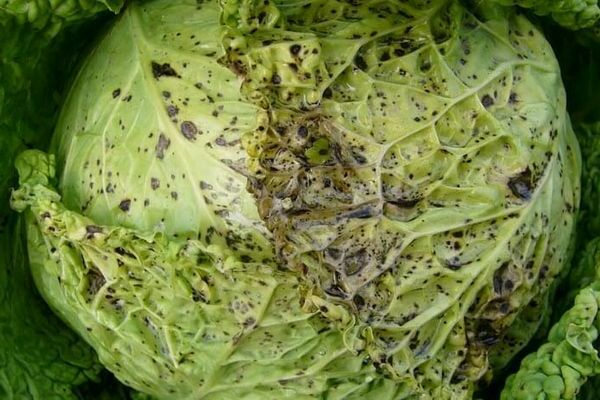
cabbage diseases
Cabbage is a vegetable, agricultural crop. A replacement can hardly be found. It is present in the diet of every person. Its wealth is its richness with vitamins. They are used both in winter preparations and fresh, in salads. That is why everyone tries to take care of the culture, to deal with problems.
Who does not know how to do this, read the article.
The most dangerous diseases of cabbage, as is commonly believed, are fungal. They spread very rapidly throughout the plant, moving to neighboring heads of cabbage.
Applying early treatment will help kill rapidly spreading fungal spores at an early stage, when there has been no major damage to the plant.
These measures allow you to save 90% of the yield. Spores, if they do not destroy the plant, then easily reduce fertility. Every gardener, even a beginner, is obliged to know the signs of diseases and how to cope with this ailment. Otherwise, it is simply not worth doing, if you do not strive for the best results.
Every disease and pest can harm more than just one cruciferous species. The species also suffer from this affliction. And therefore, any methods of dealing with the problem are trying to carry out complexes of measures to eliminate any threat to the harvest: folk, agrotechnical, chemical.
Next, we will look at common diseases and pests. As well as well-known, widely used methods of getting rid of them.
Cabbage disease - keela
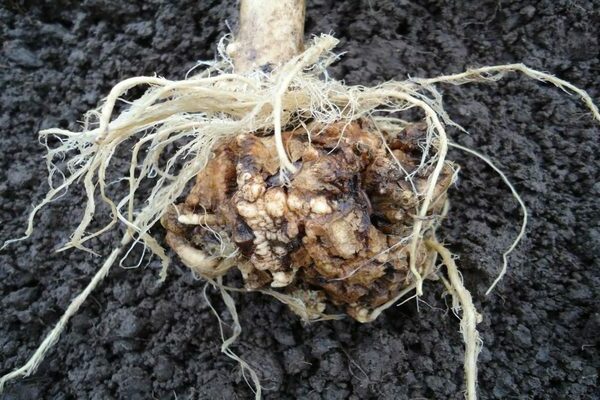
cabbage diseases
The origin of the disease is fungal. The parasitic fungus causes disease. There is a defeat of young, recently planted in the ground or greenhouse bushes. Not yet matured, not adapted to new conditions and unable to independently fight any disease or pest.
The problem of infection can arise even at the seedling stage. When the culture is exposed to an open space for ventilation. A sore appears in the form of differently shaped growths on the roots of the plant. After infection, the necessary, normal nutrition of the entire plant stops.
Further, the wilting of the cabbage, an almost complete lag in growth and development. You can understand that the plant is almost killed if you pull it slightly out of the soil. The root does not hold and the cabbage is very easily pulled out.
White cabbage and cauliflower are affected. The fungus is spread by spores. The rapid spread is facilitated by wind, rains, insects, which very quickly transfer the fungus from place to place.
Therefore, if the problem has already arisen, there will be no salvation even in the greenhouse. Since ventilation is necessary, and, accordingly, the entry of gusts of wind. There is only one way out - to urgently fight, treat. If the treatment process is started in a timely manner, the particular danger to cabbage can be avoided.
The methods, accordingly, should be gentle, not aggressive, since Keela itself does not belong to the division of especially dangerous diseases.Prevention can also prevent or reduce the incidence of this infection.
The use of prophylaxis allows you to stop the spread of the keel to neighboring beds, cruciferous crops, which can easily be affected.
It is imperative to look at all seedlings before planting in the ground or greenhouse for the possibility of being hit by a keel. When weakened, underdeveloped bushes are found, they are destroyed by removing them together with the root and a lump of earth around.
The resulting holes must be disinfected with lime by sprinkling it over the soil surface. The soil must be disinfected just before sowing for seedlings. Recommended with lime, in a ratio of 1 kilogram to 3-4 square meters.
A plus can be considered the fact that the soil removed during the destruction of a diseased plant can be used to grow other crops in the garden. After all, only cruciferous plants are infected with the keel.
Peronosporosis
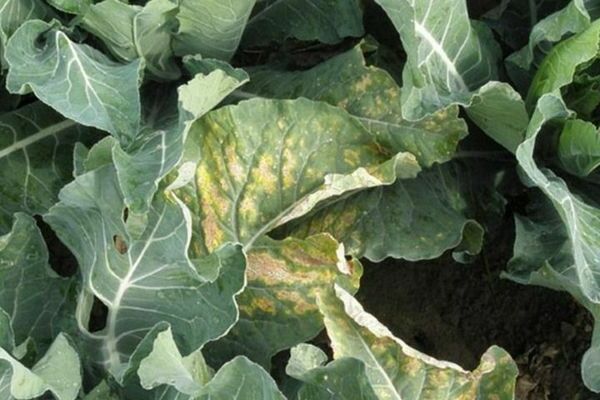
cabbage diseases
This disease is popularly called powdery downy mildew. This is another type of fungal infection of a cultivated plant. Like Keela, it affects almost all cruciferous species. It is possible to determine the disease when it has already been activated by some signs:
- manifestation occurs already at the seedling stage;
- grayish and yellow spots are formed. The leaf cover is mainly affected. On the underside, the formation of a white coating is possible;
- there is a gradual wilting of the leaves with subsequent withering away;
- development, nutrition is very slow.
High humidity outside, in a greenhouse, in a greenhouse is the most favorable conditions for parasitizing powdery mildew.
If we consider the scale of the threat when a disease appears on your plantings, you can safely prepare to destroy the entire crop. After all, the disease is spread by spores. And with the slightest wind, rain, increased activity of insects, the troubles that have arisen among gardeners will become great.
Diseases of cabbage have been known for a long time and there are a lot of methods of struggle. But experienced farmers have identified a couple of the most effective for themselves: Fitoftorin and Ridomil Gold, which have proven themselves only from the best side.
But, let's clarify right away, these are drugs of chemical origin, their actions can even be called aggressive. It is necessary to use it only according to the instructions, without amateur performance.
For lovers of everything safe, who are wary of all chemical treatments, a 1% solution of Bordeaux mixture can be recommended. Spray plantings with it. Dilute in the ratio: 200 g of the mixture in a bucket of water.
When the plants are already strong enough, the mixture needs 500 grams for the same amount of water.
No one has canceled preventive measures that contribute not only to the fight, but also to the prevention of the disease. These methods can be considered:
- compulsory soil disinfection. It is also desirable to disinfect the planting material. It is necessary to regulate soil moisture. Watering with cold water is not allowed. It contributes to the rapid development of the disease;
- annual observance of crop rotation. Beans, potatoes, and cucumbers are good precursors for cabbage. Can be planted in the area where green manure was previously grown, for example, mustard. Planting cabbage in the same place every year is contraindicated.
Fusarium
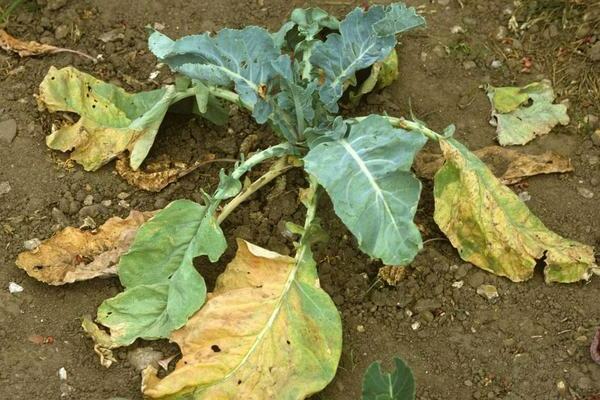
Fungal diseases of cabbage. If you find out in a timely manner and immediately begin treatment, there will be no special difficulties in the fight against the disease. Fusarium is a gradual, very noticeable wilting (tracheomycosis) caused by a fungus.
All representatives of the cruciferous family fall into the sphere of defeat. This fungus has a target of defeat - the vascular system of the plant, where it ruthlessly penetrates. Therefore, the chances for the further development of culture are practically zero.There is a blockage of blood vessels, and as a result, a speedy wilting.
The disease has a number of signs that make it possible to call Fusarium in the folk way - jaundice. Symptoms typical for this disease:
- yellowish spots are formed in the veins;
- the leaf plate slowly begins to turn yellow and further wilt;
- if the leaves are cut off at the base, brown spots and mycelium of the fungus will become noticeable on the cut;
- if the disease manifests itself at the stage of set heads, irregular shapes of the head and inappropriate small size can be observed.
For the treatment of this disease of fungal origin, the first recommendation is the urgent removal of all leaves affected by the fungus, sometimes completely of the plant. And also the treatment of all plantings with fungicide systems: Tecto, Benomil, etc.
The mushroom itself is very tenacious. It can live in the soil comfortably for up to several years, conducting its life activity in the entire spectrum of its capabilities. That is why the rules of crop rotation must always be used when planting cabbage and any other cruciferous plants.
The first rule - in no case, no landings in one for the next several years. After harvesting, it is necessary to remove not only the roots, but also all residues of vegetation. For example, cabbage leaves that are already withered. They can be harmful, as they may have a fungus on them that is not even noticeable to the eye.
It is better to play it safe and carry out tillage in the autumn, before the next season.
Cabbage viral diseases
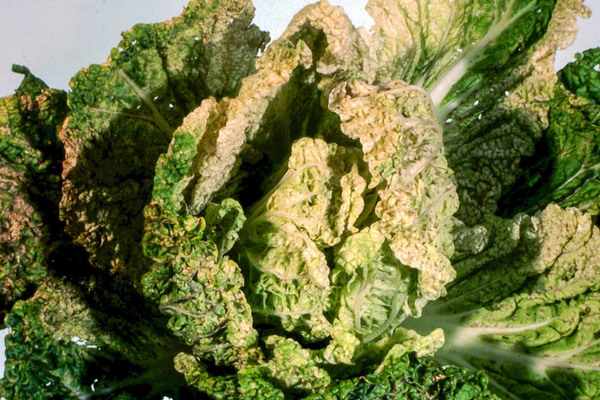
Cabbage viral diseases are rare. You can meet on 20% of the plots with cabbage planting. But the spread is rapid, infection is rapid, treatment is almost impossible - it has been proven in practice, among gardeners.
If signs of a viral disease appear on your site, the crop can be considered lost.
1. Mosaic Virus - the most famous among experienced gardeners. Beginners will still have to face such problems, and the article can help you cope, carry out prevention methods. There are a lot of mosaic varieties, the number reaches hundreds.
There are popular ones, but there are still unknown, not researched, which in turn can cause the most irreparable damage, because methods of dealing with the disease are not known.
Unlike the previous diseases considered, this one poses a significant threat to any garden crop, not only the cruciferous representative in your area may suffer. The infection is transferred very easily:
- dirty, untreated gardening tools that you use to work on every part of your garden. Having worked with one culture, it is advisable to wash the tools or process them with any available septic tank.
In general, it is recommended to wash tools after each use. After all, it is not known what may be in the soil, among the vegetation;
- parasitic insects are excellent carriers of any infection. The virus enters the stem tissue of the plant, as well as the juice of any of the seedlings. Once part of a living organism, the virus begins to mutate. Subsequently, it spreads to neighboring bushes, beds, plots.
2. Cauliflower mosaic... Cauliflower is a culture not for everyone, in vegetable gardens you can find 50 to 50. But fungal diseases are much less common on this variety of cabbage.
When choosing methods of combating the disease on colored varieties, a lot of questions arise. This area is not fully explored.
The name of the fungus - mosaic - sounds beautiful, but in fact, the fungus is considered the most dangerous for all cultures of the cruciferous family. All varieties and types of cabbage fall into the spectrum of this virus.
3. Turnip mosaic... It is possible to detect this virus, its obvious manifestation, after about a month, when the seedlings have already been planted.When on the leaf cover there are edges along the length of the veins of a dark green color.
A little later, they develop into spots, filling the space between the veins. If the virus is in an advanced stage, its manifestation can be observed on the heads of cabbage. Most of the spots are visible on the underside of cabbage leaves.
Further, the growth of spots occurs, followed by merging into large spots of dark green color, necrotic spots. There comes a process of defoliation - leaf fall, which occurs out of time.
The Turnips mosaic has a viral nature. Insecticides cannot help combat this problem. It is not amenable to treatment with such drugs. But there are preventive measures that are given special attention:
- obligatory disinfection of seeds before planting for seedlings;
- if even weak signs of infection are found, it is necessary to completely remove the plant, along with a lump of soil where the bushes are planted;
- in this case, even weeds can become carriers of the virus, so regular weeding between and around the bushes;
- parasites are another carrier of infection, they must be fought with. Such representatives can be ticks and aphids, the fight against them must be effective. Also, the virus can spread with mechanical damage. Therefore, all work should be carried out carefully, without damaging the leaves, head of cabbage, and stump.
Parasites are animals that can cause massive damage to crops
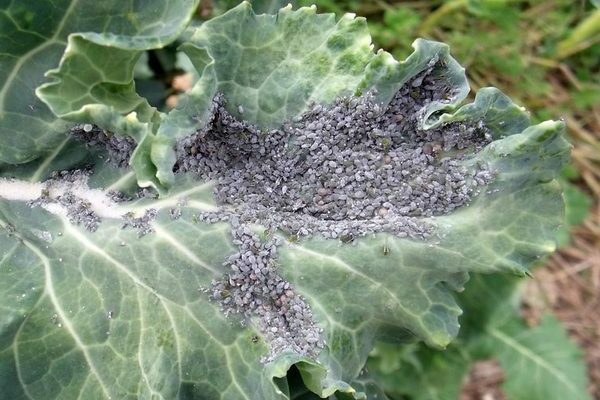
Young plants are especially attractive to pests. Already at an early stage, when the seedlings have not yet matured, in the spring, an active attack by pests begins. Not only damage to the plant occurs, but also the transfer of all viral and fungal infections present.
To obtain a good, healthy, abundant harvest of cabbage, it is necessary, first of all, to carry out prophylaxis, treatment with special preparations. Prevention should be systematic.
In our article, we analyze all common pests, diseases, and acceptable ways to deal with the problem that has arisen.
Let's analyze common pests:
Cabbage aphid.
Irregular processing of the culture or its absence will inevitably lead to the appearance of parasites, for which white cabbage will become an attractive delicacy. The fight against insects is many times more difficult than the prevention of the appearance of such pests.
Aphids in this case are one of the representatives of harmful insects. Her nutrition consists of cabbage juice. It has a small size, white-silver color. They are located on the lower base of cabbage leaves.
Over time, the leaves are completely depleted, since the sap - the basis of nutrition for the entire plant - is formed precisely in the leaf cover. Therefore, aphids are very dangerous. It begins its activity in the spring, when the seedlings have just been planted in a permanent place.
The settlement of aphids colonially occurs on the leaves (lower part) of young plants. There are some signs of an insect on your plantings:
- there was an inexplicable slowdown in the development of seedlings;
- the natural color of the leaves is lost. The subsequent appearance of a pink tint;
- the leaves are twisting. As a rule, the leaves die.
To destroy the hordes of insects, you will have to use insecticides. It will not be possible to cope otherwise if everything is running. Such drugs will be: Iskra, Karbofos, Karate.
Folk remedies are also widely used. It's just that the use of those will occur more often, since their effect is much weaker. But there is also a plus - such funds are safer for humans and the surrounding animal world. Here are examples of such folk remedies:
- the smell of tobacco is very sharp, scares away insects at a decent distance;
- an infusion of garlic or onion peels also create an unpleasant aroma that repels aphids;
- if you plant tomatoes and carrots next to cabbage plantings, the number of insects will significantly decrease, aphids do not tolerate such neighbors.
Cabbage fly.
White cabbage and cauliflower suffer from this representative. In appearance, there is practically no difference from a simple housefly familiar to all.
Cabbage is very dangerous. Its activity begins in the second half of May, eggs are laid in the soil cover.
In a very short time, just a week, the larvae have already begun their harmful activity, preferring to feast on the cabbage root system. The presence of such a pest can be detected by a number of signs:
- appearance, root rotting. When trying to pull a plant out of the ground, no effort is required, it happens easily;
- bushes begin to fade;
- a grayish-lead shade begins to predominate on the lower leaves.
At the first detection, it is necessary to apply treatment with Thiophos solution, 30%. The concentration with water should be 0.03%, we consume about 0.25 liters per plant.
The use of Chlorophos solution also has an effective effect. The percentage of the solution is 65%, the concentration in the composition with water is 0.25%. We spend 0.2 liters for one bush.
You can also use folk methods, but much more often. Again, the familiar tobacco smell. But it must be mixed with lime, in equal proportions. A mixture of seven parts sand and 1 part naphthalene will also help in this matter.
Flea Cruciferous.
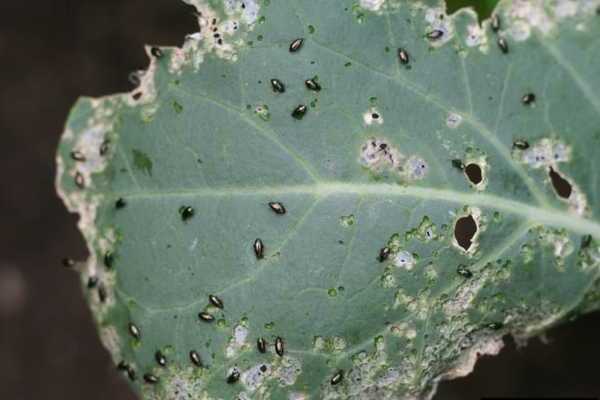
Small bugs with an oblong body and black color. The habitat is mainly in the soil cover. But with the onset of spring warming, they begin their activity, parasitizing on young plants. The first to suffer are simple early weeds, later - the planted seedlings.
The defeat occurs not only in cabbage, but also in all crucifers. Flea beetles feed on the top layer of the leaf, after which small ulcers form.
If young plants are attacked, almost 100% of the crop will die. Since the cabbage has not grown strong, it does not tolerate the attacks of such a pest. Older plants can already struggle somehow, but the yield is still significantly reduced.
A feature of such a flea is considered to be intolerance to wet weather. When fighting, they use proven folk remedies:
- spraying with soapy water of both young and mature plants;
- wood ash can be used by dusting. In this case, some gardeners use simple road dust.
Chemicals that have proven themselves from the effective side are also used: Aktara, Karbofos.
The presence of insect pests or cabbage disease can be identified by signs. It's just that sometimes it's too late. Therefore, mandatory prevention, for which they use not only the correct agricultural technique of planting, but also use all kinds of folk remedies.
Processing with such improvised materials will not be able to harm, but it is easy to prevent the occurrence of most problems. The first symptoms are immediate prevention and initial treatment.
If the stage of damage has already exceeded the minimum, we use drugs of chemical origin. All measures taken on time will help save your long-awaited harvest.

